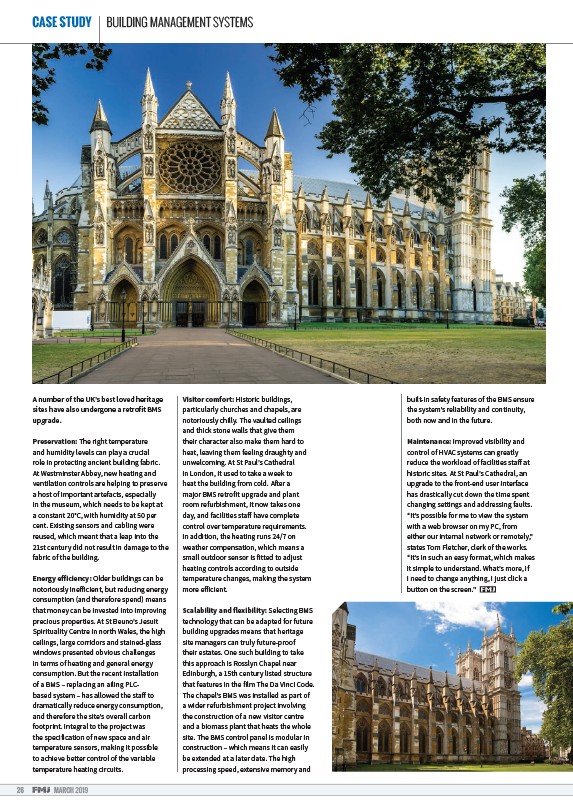
CASE STUDY BUILDING MANAGEMENT SYSTEMS
26 MARCH 2019
builtin
safety features of the BMS ensure
the system’s reliability and continuity,
both now and in the future.
Maintenance: Improved visibility and
control of HVAC systems can greatly
reduce the workload of facilities staƒ at
historic sites. At St Paul’s Cathedral, an
upgrade to the frontend
user interface
has drastically cut down the time spent
changing settings and addressing faults.
“It’s possible for me to view the system
with a web browser on my PC, from
either our internal network or remotely,”
states Tom Fletcher, clerk of the works.
“It’s in such an easy format, which makes
it simple to understand. What’s more, if
I need to change anything, I just click a
button on the screen.”
A number of the UK’s best loved heritage
sites have also undergone a retrofit BMS
upgrade.
Preservation: The right temperature
and humidity levels can play a crucial
role in protecting ancient building fabric.
At Westminster Abbey, new heating and
ventilation controls are helping to preserve
a host of important artefacts, especially
in the museum, which needs to be kept at
a constant 20°C, with humidity at 50 per
cent. Existing sensors and cabling were
reused, which meant that a leap into the
21st century did not result in damage to the
fabric of the building.
Energy e iciency: Older buildings can be
notoriously ineƒ icient, but reducing energy
consumption (and therefore spend) means
that money can be invested into improving
precious properties. At St Beuno’s Jesuit
Spirituality Centre in north Wales, the high
ceilings, large corridors and stainedglass
windows presented obvious challenges
in terms of heating and general energy
consumption. But the recent installation
of a BMS – replacing an ailing PLCbased
system – has allowed the staƒ to
dramatically reduce energy consumption,
and therefore the site’s overall carbon
footprint. Integral to the project was
the specification of new space and air
temperature sensors, making it possible
to achieve better control of the variable
temperature heating circuits.
Visitor comfort: Historic buildings,
particularly churches and chapels, are
notoriously chilly. The vaulted ceilings
and thick stone walls that give them
their character also make them hard to
heat, leaving them feeling draughty and
unwelcoming. At St Paul’s Cathedral
in London, it used to take a week to
heat the building from cold. A er a
major BMS retrofit upgrade and plant
room refurbishment, it now takes one
day, and facilities staƒ have complete
control over temperature requirements.
In addition, the heating runs 24/7 on
weather compensation, which means a
small outdoor sensor is fitted to adjust
heating controls according to outside
temperature changes, making the system
more eƒ icient.
Scalability and flexibility: Selecting BMS
technology that can be adapted for future
building upgrades means that heritage
site managers can truly futureproof
their estates. One such building to take
this approach is Rosslyn Chapel near
Edinburgh, a 15th century listed structure
that features in the film The Da Vinci Code.
The chapel’s BMS was installed as part of
a wider refurbishment project involving
the construction of a new visitor centre
and a biomass plant that heats the whole
site. The BMS control panel is modular in
construction – which means it can easily
be extended at a later date. The high
processing speed, extensive memory and